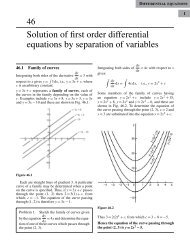integration
Create successful ePaper yourself
Turn your PDF publications into a flip-book with our unique Google optimized e-Paper software.
Integral calculus<br />
41<br />
Integration using partial fractions<br />
It was shown in Problem 2, page 19:<br />
41.1 Introduction<br />
2x 2 − 9x − 35<br />
The process of expressing a fraction in terms of (x + 1)(x − 2)(x + 3) ≡ 4<br />
(x + 1) − 3<br />
(x − 2) + 1<br />
(x + 3)<br />
simpler fractions—called partial fractions—is discussed<br />
in Chapter 3, with the forms of partial frac-<br />
2x 2 − 9x − 35<br />
∫<br />
tions used being summarized in Table 3.1, page 18. Hence<br />
(x + 1)(x − 2)(x + 3) dx<br />
Certain functions have to be resolved into partial ∫ {<br />
fractions before they can be integrated as demonstrated<br />
in the following worked problems.<br />
(x + 1) − 3<br />
(x − 2) + 1 }<br />
4<br />
≡<br />
dx<br />
(x + 3)<br />
= 4ln(x + 1) − 3ln(x − 2) + ln(x + 3) + c<br />
{<br />
}<br />
41.2 Worked problems on <strong>integration</strong><br />
(x + 1) 4 (x + 3)<br />
or ln<br />
using partial fractions with linear<br />
(x − 2) 3 + c<br />
factors<br />
∫<br />
∫<br />
x<br />
11 − 3x<br />
2 + 1<br />
Problem 1. Determine<br />
x 2 + 2x − 3 dx. Problem 3. Determine<br />
x 2 − 3x + 2 dx.<br />
By dividing out (since the numerator and denominator<br />
are of the same degree) and resolving into partial<br />
As shown in problem 1, page 18:<br />
11 − 3x<br />
x 2 + 2x − 3 ≡ 2<br />
(x − 1) − 5<br />
fractions it was shown in Problem 3, page 19:<br />
(x + 3)<br />
x 2 + 1<br />
x 2 − 3x + 2 ≡ 1 − 2<br />
(x − 1) + 5<br />
(x − 2)<br />
∫<br />
11 − 3x<br />
Hence<br />
x 2 + 2x − 3 dx<br />
∫<br />
x 2 + 1<br />
Hence<br />
∫ {<br />
2<br />
=<br />
(x − 1) − 5 }<br />
x 2 − 3x + 2 dx<br />
∫ {<br />
dx<br />
(x + 3)<br />
≡ 1 − 2<br />
(x − 1) + 5 }<br />
dx<br />
(x − 2)<br />
= 2ln(x − 1) − 5ln(x + 3) + c<br />
= (x − 2) ln(x − 1) + 5ln(x − 2) + c<br />
{ }<br />
(by algebraic substitutions — see Chapter 39)<br />
(x − 2) 5<br />
{ }<br />
or x + ln<br />
(x − 1) 2<br />
(x − 1) 2 + c<br />
or ln<br />
(x + 3) 5 + c by the laws of logarithms<br />
Problem 4. Evaluate<br />
∫<br />
Problem 2. Find<br />
3<br />
x 3 − 2x 2 − 4x − 4<br />
∫<br />
2x 2 2 x<br />
− 9x − 35<br />
2 dx,<br />
+ x − 2<br />
(x + 1)(x − 2)(x + 3) dx correct to 4 significant figures.










